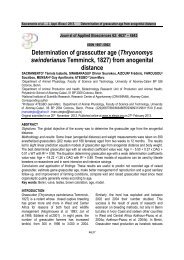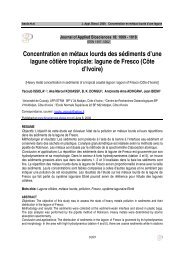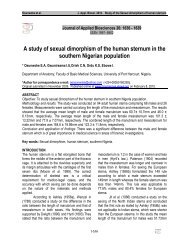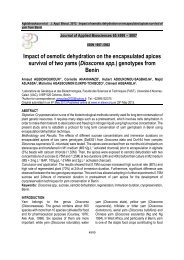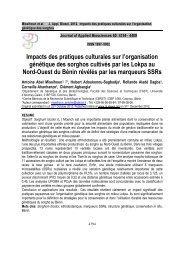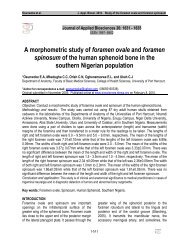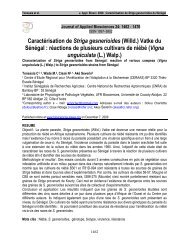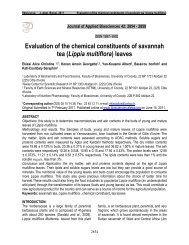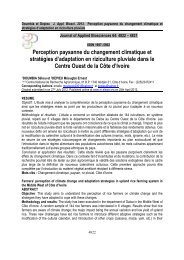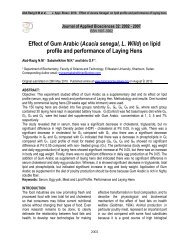Biofuels in Tanzania: Status, Opportunities and Challenges
Biofuels in Tanzania: Status, Opportunities and Challenges
Biofuels in Tanzania: Status, Opportunities and Challenges
Create successful ePaper yourself
Turn your PDF publications into a flip-book with our unique Google optimized e-Paper software.
Anthony M. Msh<strong>and</strong>ete.J. Appl. Biosci. 2011. <strong>Biofuels</strong> <strong>in</strong> <strong>Tanzania</strong>: <strong>Status</strong>, <strong>Opportunities</strong> <strong>and</strong> challengesproduction of Jatropha <strong>in</strong> <strong>Tanzania</strong> is 80% private, 56%plantation <strong>and</strong> 22% mixed (GEXSI, 2008). It is thespread of these large-scale operations, which is driv<strong>in</strong>gmany of the social <strong>and</strong> environmental concerns aboutbiofuel production <strong>in</strong> Africa (Scott, 2009) <strong>and</strong> <strong>in</strong><strong>Tanzania</strong> at present (Sulle & Nelson, 2009a).Plantation agriculture is often based on monoculture ofa s<strong>in</strong>gle variety or cultivar, which <strong>in</strong>creases risks ofpests <strong>and</strong> disease impacts, necessitat<strong>in</strong>g <strong>in</strong>tensivemanagement with tillage, fertilizers, pesticides,herbicides <strong>and</strong> other chemical <strong>in</strong>puts (RSB-GUI, 2009).Details of classification criteria for development ofbiofuels <strong>in</strong> <strong>Tanzania</strong>, features of productionmodel/drawbacks <strong>and</strong> reasons for production modelhave been reported elsewhere (Messemaker, 2008;Mart<strong>in</strong> et al., 2009; Sulle & Nelson, 2009a). Table 4summarizes production models, productionarrangement, status <strong>and</strong> challenges of exist<strong>in</strong>g,prospective <strong>and</strong> emerg<strong>in</strong>g biofuel crops productionarrangement <strong>in</strong> <strong>Tanzania</strong>.Players <strong>and</strong> <strong>in</strong>stitutions <strong>in</strong>volved <strong>in</strong> biofuels <strong>in</strong><strong>Tanzania</strong>: The motivations for governments toaggressively pursue biofuel development are complex<strong>and</strong> multidimensional s<strong>in</strong>ce it entails exploitation of fourpr<strong>in</strong>cipal resources namely; l<strong>and</strong>, forests, waterresources <strong>and</strong> labour (Kamanga, 2008). To ensure thesusta<strong>in</strong>ability of biofuels enterprise <strong>and</strong> those fourstrategic important resources, different countries of theworld are develop<strong>in</strong>g their national strategies on biofueldevelopment to <strong>in</strong>clude environmental <strong>and</strong> socialcriteria/aspects, which are <strong>in</strong>tricately <strong>in</strong>terrelated.<strong>Biofuels</strong> can be regarded as <strong>in</strong>tegral part of emerg<strong>in</strong>gbio-economy with great development expected tocome especially for those countries like <strong>Tanzania</strong> withagriculture as the ma<strong>in</strong> activity. Production of liquidbiofuels; bioethanol <strong>and</strong> biodiesel <strong>in</strong> <strong>Tanzania</strong> is new<strong>and</strong> still <strong>in</strong> its <strong>in</strong>fancy stage. Nevertheless, the biofuel<strong>in</strong>dustry has attracted a wide range of <strong>in</strong>vestors.Besides a h<strong>and</strong>ful of local firms, foreign firms fromEurope, USA, Japan <strong>and</strong> the Far East dom<strong>in</strong>ate thebiofuel development <strong>in</strong>itiative <strong>and</strong> <strong>in</strong>vestment(s) ma<strong>in</strong>lyoften with the <strong>in</strong>tention to export. This is oftenimplicated ma<strong>in</strong>ly to the fact that <strong>Tanzania</strong> as adevelop<strong>in</strong>g country lacks the necessary technology forthe production of biofuels <strong>and</strong> capital <strong>in</strong>vestment. Tothat effect the country currently encourages foreign<strong>in</strong>vestment <strong>in</strong> biofuels <strong>and</strong> the likelihood of foreign<strong>in</strong>vestors dom<strong>in</strong>at<strong>in</strong>g the <strong>in</strong>dustry is a clear reality. Theforeign biofuel <strong>in</strong>dustry dom<strong>in</strong>ance <strong>and</strong> impact <strong>in</strong><strong>Tanzania</strong> should not be underestimated but be taken aspolicy po<strong>in</strong>ter s<strong>in</strong>ce their dom<strong>in</strong>ance <strong>in</strong> local economiesmay also limit opportunities to negotiate equitable<strong>in</strong>clusion. The roles of different actors/players <strong>in</strong><strong>Tanzania</strong> are summarized <strong>in</strong> Table 5.2686



